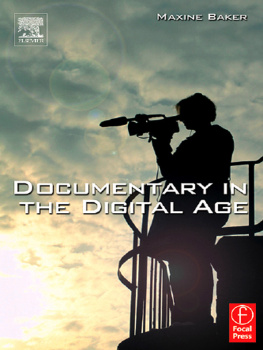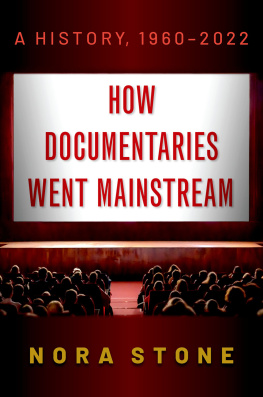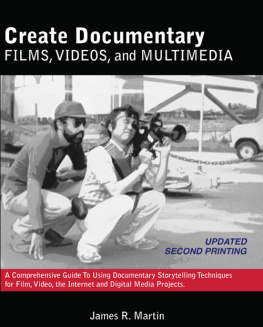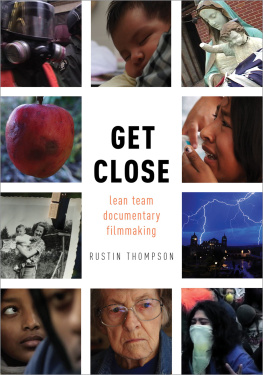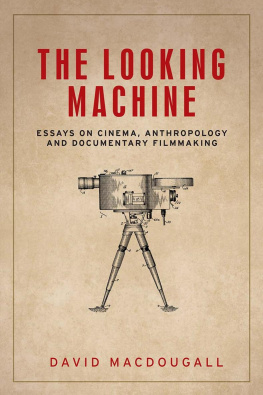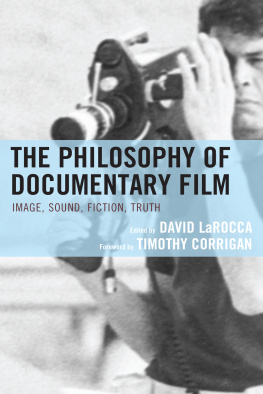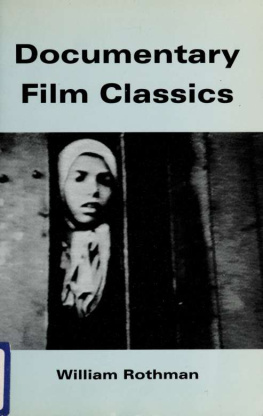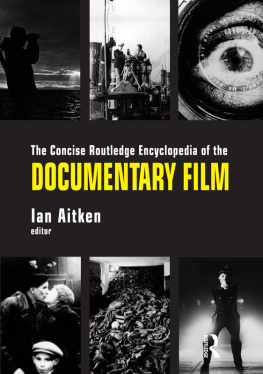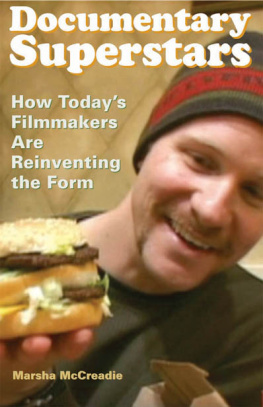Documentary in the Digital Age
Documentary in the Digital Age
Maxine Baker

First published 2006
This edition published 2013
by Focal Press
70 Blanchard Road, Suite 402, Burlington, MA 01803
Simultaneously published in the UK
by Focal Press
2 Park Square, Milton Park, Abingdon, Oxon OX14 4RN
Focal Press is an imprint of the Taylor & Francis Group, an informa business
Copyright 2006 Maxine Baker.
The right of Maxine Baker to be identified as the author of this work has been asserted in accordance with the Copyright, Designs and Patents Act 1988
All rights reserved. No part of this book may be reprinted or reproduced or utilised in any form or by any electronic, mechanical, or other means, now known or hereafter invented, including photocopying and recording, or in any information storage or retrieval system, without permission in writing from the publishers.
Notices
Practitioners and researchers must always rely on their own experience and knowledge in evaluating and using any information, methods, compounds, or experiments described herein. In using such information or methods they should be mindful of their own safety and the safety of others, including parties for whom they have a professional responsibility.
To the fullest extent of the law, neither the Publisher nor the authors, contributors, or editors, assume any liability for any injury and/or damage to persons or property as a matter of products liability, negligence or otherwise, or from any use or operation of any methods, products, instructions, or ideas contained in the material herein.
British Library Cataloguing in Publication Data
A catalogue record for this book is available from the British Library
Library of Congress Cataloguing in Publication Data
A catalogue record for this book is available from the Library of Congress
ISBN-13: 978-0-240-51688-2 (pbk)
Contents
Acknowledgements
I would like to thank Georgia Kennedy of Focal Press for her patience, guidance and support. Also Beth Howard, who originally commissioned the book, and the editor who took over from her, Emma Baxter. I am especially grateful to Alex Cooke, who read the manuscript and offered excellent advice and support throughout. Mark Boulos researched and compiled the sections advising on documentary festivals and funding, and Pierre Haberer offered his great technical expertise with the new technology. I thank them both for their efficiency, patience and constant good humour.
The book could not have been written without the support of the UK's National Film and Television School at Beaconsfield. Special thanks to Roger Crittenden, the Academic Director, and to the knowledgeable and courteous film library staff, Noel Greenwood and Simon Aylward. Also to the Documentary Department, Dick Fontaine and the many students who helped with this project, particularly Simon Chambers, Julie Moggan and Piers Sanderson. Also, my attitudes throughout have been influenced by my work at the Cuban International Film and Television School. The perspective from Latin America is always so important and often so different from the Anglo-Saxon consensus. I have learned a lot from both staff and students, and I really appreciate their patience in explaining to me their different world view.
Peter Dale at Channel 4 and Nick Fraser at BBC's Storyville were both supportive to the project, intellectually stimulating, full of great ideas and always ready to help. Both are distinguished filmmakers in their own right. With commissioners, this is not always the case, so we are lucky.
Looking back over my long and very happy life in documentary, I realize there is one other group of people I should thank Clem Attlee and the Labour government of 1945. Without them I would never have been able to go to university or to write this book. On behalf of myself and my generation, I salute their memory!
Finally, of course, I thank my long-suffering friends. And I would like to dedicate the book to my godmother and aunt, Kate Ford, to my brother Roy and to the memory of my parents, Margaret and Wilfred Baker.
Maxine Baker
London
Introduction: Life on the Run
There are very few clearly definable turning points in history. One of those rare moments happened in Paris in December 1895, when the Lumire brothers introduced their brand new moving picture show to a paying audience. That was the day that cinema was born. All the experiments, the invention of different systems to project moving pictures in different parts of the world, had been of great interest, technologically, but cinema requires an audience. And that first cinema show, run by the Lumires, was pure documentary. They described their scenes of everyday life, filmed around their home and factory near Lyons, as life on the run. I have always thought this a perfect description of those vibrant fragments of French life at the turn of the nineteenth/twentieth century; a great definition, as well, of the word documentary. The phrase is so much more evocative than John Grierson's clinically precise description of the genre, the creative treatment of actuality.
This book looks at life on the run, twenty-first century style, Documentary in the Digital Age. The Lumires' brilliant invention, the cinematograph, was a machine which filmed, processed, projected and also, being portable, it could be taken anywhere with a minimum of fuss and used to record and display to an audience the world in which they lived. The Lumires chose to film real people in real situations, never showing any interest in dramatic stories. That is why I think that they are the true fathers of the documentary form.
It has taken film technology 100 years to catch up and overtake them. A century after that first screening in Paris, we finally have a camera which can rival and outstrip the cinematograph. Granted, the digital video camera cannot project its pictures to an audience but it can play them back in the camera. And it can keep filming for long periods without having to change tapes. And it records sound. It is cheap, it is lightweight, the picture and sound quality are constantly improving, and it is user friendly. A single operator can take it anywhere and record our own contemporary lives on the run.
The invention of the DV camera has had a massive influence on documentary. So too has the development of digital video editing, sound recording and post-production, and of course also digital tools for animation. This book will not be concentrating on the camera or indeed any other particular aspect of the technology, although the technology is fundamental to the story.
It is my considered opinion that all new aesthetic developments in documentary have followed on from technical breakthroughs. In the 1930s and 1940s, for example, some of the most compelling and beautiful documentaries were made, but they only really became possible after sound came to the movies. In the 1960s, the invention of 16 mm cameras with sync sound shepherded in the movements known variously as cinma vrit, direct cinema or fly on the wall. Now we have the digital technology which has liberated film-making in so many ways. In documentary, the effect has been immense.
I believe that we are now in the middle of a new golden age of documentary. What makes this one different and therefore, for me, more exciting is that there are so many people working in different styles with different approaches to the documentary genre. For years, the vrit aesthetic dominated documentary production and this, as a form, was often unduly restrictive and creatively stifling. Of course, some brilliant films came out of that whole movement, but I am convinced that some other brilliant films, stylistically different films, were not being made when they could and should have been made. After all, film-making was a very expensive business until recently, so the small number of television commissioning editors still the main source of funding for most documentarists had a great deal of power. Some of them were very narrow-minded, even conservative, in their approach.
Next page
